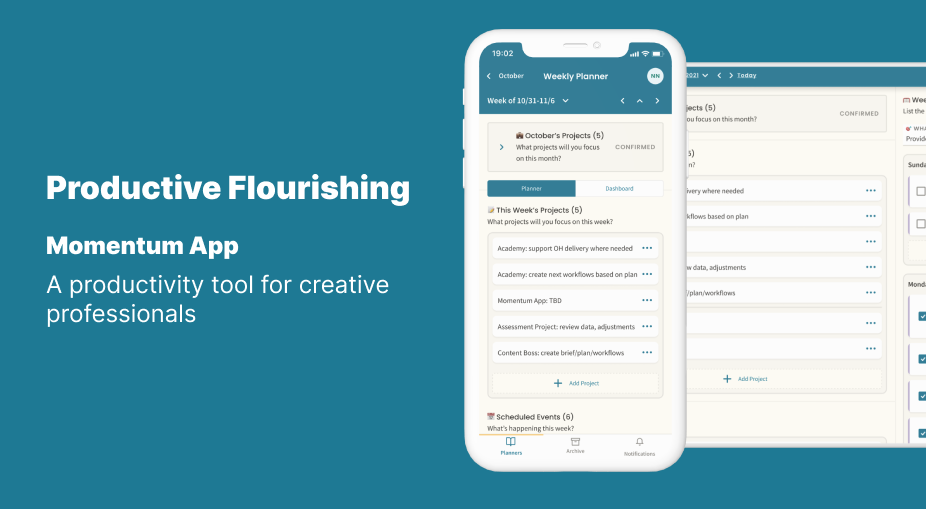Overview
Productive Flourishing’s Momentum Planner—originally a paper-based productivity tool—empowers creatives to break down big goals into manageable tasks. With growing user demand for digital solutions, the goal was to transform the planner into an adaptive web app, expanding its reach and transitioning to a subscription-based model.
The Challenge
The core objective was to replicate the planner’s strategic framework while enhancing flexibility, accessibility, and user personalization. Productive Flourishing aimed to secure 8,000 paid subscribers by converting existing customers and attracting new ones.
Funding Strategy:
- Kickstarter Campaign: Raised $42,224 from 445 backers within 24 hours using MVP mockups to showcase the product.
- Angel Investors: Supplemented funding, ensuring resources for a complete product build-out.
Design Approach
The project followed a milestone-based delivery approach, focusing on iterative development:
- Design Prototype – For initial user feedback and crowdfunding.
- Minimum Lovable Product (MLP) – A functional version used to attract investors and beta users.
- Full Feature Build-Out – Including daily, quarterly, and annual planning views.
User Research & Insights
Two rounds of user interviews guided product decisions:
Round 1 – Planning Habits & Pain Points:
- Users struggled with manually updating paper planners.
- Integration with Google Calendar was critical.
- Desired features: drag-and-drop, free-form note areas, 12/24-hour time formats, and easy navigation between daily to yearly views.
Round 2 – Subscription Viability & Engagement
- Users were excited about the app and willing to pay ~$10/month.
- Customization options (themes, colors, emojis) were highly valued.
Design Solutions
Several users of “The Momentum Planner” paper products are neurodivergent. I considered the needs of these customers by carefully considering the color schemes, typography and personalization of each user’s planner.
Adaptive Web App
Designed for both desktop and mobile for seamless planning across devices.
Design for Neuro-divergence
- Thoughtful color schemes and typography.
- A special “Sparkly” theme using dyslexia-friendly fonts and vibrant colors.
Google Calendar Integration
Two-way syncing, with improvements to include events from multiple calendars.
Drag & Drop Functionality
Simplified task management with Trello inspired movement of tasks and projects.
Navigation Enhancements
- Breadcrumbs for quick navigation across different planner views.
- Planner Drawer for structured hierarchy from annual to daily plans.
Archiving Logic
Implemented a “Russian nesting doll” system—archiving top-level projects would also archive all related tasks unless manually detached.
Personalization & User Control
- Multiple themes, including:
- Base UI (calm sea-green, aligned with Productive Flourishing branding)
- Corporate Blue (a more traditional, professional look)
- Sparkly (designed for neurodivergent users)
- Customizable time/date settings, start-of-week preferences, and time zone awareness.
- Color-coded projects and free-form notes for user expression.
Outcomes
- Fully funded on Kickstarter in under 24 hours.
- Achieved 500 Monthly Active Users post-launch.
- 14 five-star reviews and 262 followers on Product Hunt.
- Successfully transitioned from paper to digital, enhancing user experience and opening new revenue streams.
Key Learnings
- Toast messages, while helpful for undo actions, led to user fatigue—highlighting the importance of selective notifications.
- Personalized user experiences and neurodivergent-friendly features directly increased user engagement.
- Continuous user feedback was critical in shaping the app’s success.
Conclusion
MomentumApp is a prime example of how user-centered design can transform traditional tools into modern digital solutions. By focusing on flexibility, personalization, and user needs, the app not only preserved the planner’s core philosophy but also expanded its functionality, accessibility, and market reach.



